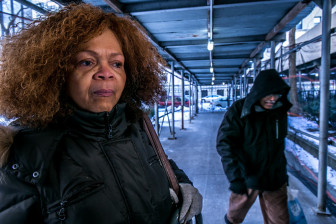
Gobonodo
The massive Co-op City complex in the Bronx was built under the Mitchell-Lama program.
According to a 2011 Furman Center report, 97 Mitchell-Lama co-ops, with 69,700 units, were built in New York City. Relatively few co-ops have left Mitchell-Lama, but some exits have prompted huge debates, such as at the 1651-unit Southbridge Towers in Lower Manhattan. Cooperators at Southbridge, paid about an average of $17,500 for their co-ops, with an average monthly maintenance fee of $620, the Times reported last year. When the units go to market, the Southbridge offering plan—according to the Times—predicts that a shareholder could sell a one-bedroom apartment for $550,000 and reap $325,000 after a significant flip tax.
Should those who have benefited from affordability get an unfair “windfall profit,” as Cooperators United for Mitchell-Lama (CUML) dubs it? Or do they deserve an award for taking a risk by moving to a community decades ago and helping it serve as a magnet for growth?
Defenders note that the program began with a time horizon, and also note that co-op sales generate new tax revenue because all co-op sales are taxed. Many would like to pass on an asset to their children. They got a boost last December, when a state court ruled that those buildings leaving the program were not subject to the city’s Real Property Transfer Tax; a lawyer for those considering privatizing told the Daily News that residents would be “dancing in the street.”
Critics, however, believe Mitchell-Lama cooperators are cashing in on an affordable housing investment made by someone else—namely, taxpayers. Max Weselcouch, director of the Moelis Institute for Affordable Housing Policy at the NYU Furman Center, contrasts the Mitchell-Lama rentals, where the owners took on some risk with the expectation of an eventual market-rate future, with the co-ops, whose shareholders took on less risk.
“They have the potential for a huge profit in buying out,” she observes. “It’s unclear whose interest that is in. The city and state invested in these properties when they were built. Now they won’t be available for future generations.”
As with Mitchell-Lama rentals, hindsight suggests an awkward fit with today’s city. “I think if someone were to design a limited equity program today,” Weselcouch suggested, “there probably wouldn’t be an option for shareholders to opt out.”
HPD has begun a co-op buyout plan in which buildings can be converted under state law to income-restricted buildings, which would provide the cooperators with some limited growth in their equity. Once outside Mitchell-Lama, however, the building’s waiting list—the next generation for entry—would be eliminated, since the units could be sold on the open market. And while buyers would face income limits and restrictions on sales prices, Cooperators United for Mitchell-Lama has warned this will put the buildings out of reach of many previously eligible to buy in.
 In Rising Market, Vital Mitchell-Lama Program at Crossroads
In Rising Market, Vital Mitchell-Lama Program at CrossroadsDeep repair needs and an alluring private market are pushing the mostly middle-class complexes toward the open market, eroding a bulwark of affordability. Read more …
City Limits’ coverage of housing policy is supported by the Charles H. Revson Foundation.
* * * *









5 thoughts on “Are Co-Op Owners Entitled to ‘Windfall’ Profits?”
Interesting cover photo: The original Co-op City residents were enticed from their rent-controlled apartments to stay within the NYC limits rather that White Flight out to suburbia by an unreasonably low estimated mortgage that was revealed to be triple the estimate (leading to the mid-1970s rent strike). That was a broken promise in addition to what seems to be on the verge of being a second broken promise, that as you said had a time horizon.
Suppose if instead of their equity payment, someone had used that cash for a down-payment on an unemcumbered single family home or a condominium unit, and had used the same monthly carrying charge for costs and maintenance, and whatever was left for amortization? What would their “windfall” profit be?
How about someone go after the billionaires that steal from the taxpayers with back room deals and loopholes a plenty. Real dollars from the 1%, not the working class that helped rebuild a neighbor so that the new developers avoid taxes.
95% Property Tax Break Paid for by You, Enjoyed by Billionaires
http://www.wnyc.org/story/years-95-property-tax-break-paid-you-enjoyed-billionaires/?utm_content=buffer9c0be&utm_medium=social&utm_source=facebook&utm_campaign=wnyc-facebook
Moelis Institute for Affordable Housing Policy- bahhaaaaa. Ron Moelis REBNY member, who is buying NYCHA housing, who benefits from tax breaks, but leaves residents with shoddy built housing.
The law permits the conversion to a private co op. Talk about the politics of affordable housing in irrelevant
I know many people who make great salaries that have lived in the subsidized Southbridge Towers for years. it’s a scam. These people get their families in and occupy at least 6 subsidized apartments. Then when it privatized they reaped the benefits from taxpayers. How can this happen?